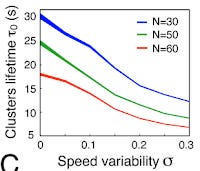Why Does Speed Variability Create Congestion?

Above are the results from one trial of an experiment designed to answer this question. Participants were randomly assigned to one of two groups, each with its own walking direction and color.
The authors defined "clusters" as groups of people walking in basically the same path, with some leeway. They then did simulations to determine the average lifetime of a cluster as a function of the group's variability in walking speed. As you can see, the greater the variability, the shorter the lifetime of the clusters.

N = the number of pedestrians in the simulation
This trend fits with their experimental results. Here's how the authors explain it:
[T]hose moving faster catch up with those walking slower, leaving an empty zone in front of the slow walkers ... [P]edestrians who are willing to walk faster than others make use of density gaps to overtake the slow walkers in front of them. By doing so, faster pedestrians move away from their lane, and meet the opposite flow head-on a few seconds later. This initial perturbation often triggers a complex sequence of avoidance maneuvers that results in the observed global instabilities.
So here's a situation where more diversity, defined as inter-individual variability, leads to worse outcomes. Of course, as the authors mention, there are many other situations, such as collective decision making, where inter-individual variability is actually quite helpful.
Perhaps more diversity generally serves the function of pushing a group out of local optima. So you can think of diversity as shifting a group more towards the "explore" side of the exploration-exploitation trade-off. This would hurt in situations with a clearly defined goal, such as pedestrians walking in a circle as quickly as possible. But it might help in more complex situations.

